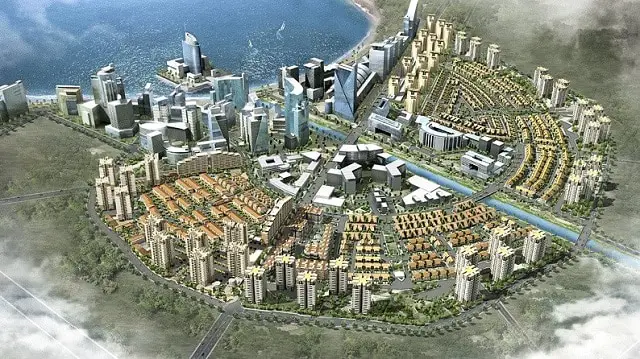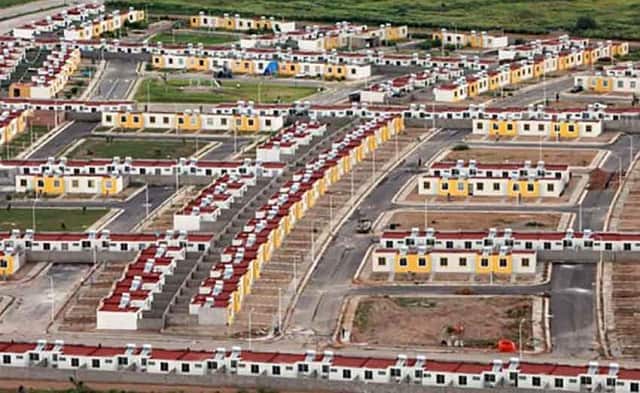The satellite city is one of the popular concepts in the urban planning. It is the small metropolitan area is located near to the large metropolitan area. The satellite town has the traditional downtown that surrounded by the neighborhoods of inner city. The satellite city manages the urban sprawl. The satellite town provides best solution to the urbanisation problems and the migration.
The satellite town is designed to help the city extend in the effective way. It is the medium sized cities close to the metropolitan cities. It is planned city that is loaded with the huge range of the amenities such as school, hospital, shopping center and others. The satellite town is separated from the metropolis by the geographic barrier, territory and others such as river. The main purpose of the satellite city is to offer the balance between the resources and population.
A satellite is a reference derived from astronomy which is a study of space and celestial objects. As a definition, an artificial satellite is an object that is sent to space which is within the orbit of the earth but not part of the earth. Planets in space often have natural satellites that are within the orbit of the planet but not actually part of the planet. The best example of this is the moon which orbits the earth and is a natural satellite of earth but is not part of the earth itself. This concept is used in describing a satellite city.
Related Articles
- Top 10 Differences Between Village Life and City Life
- City Life – Why people prefer to live in cities?
- Top 10 Disadvantages of City Life | Pollution, Stress, Expenditure
- Classification of Towns as per Census of India 2011
What is a Satellite City?
There are many large metropolitan cities all over the world. Cities like Delhi, New York, London, Sydney, Los Angeles, Mumbai, Shanghai, Beijing, and Rio de Janeiro have large populations. There are hundreds of cities all over the world today that have populations of more than a million people. Some cities have populations over 20 million people. These are extremely large metropolitan areas in various different parts of the world. Satellite Cities are metropolitan cities that are smaller cities that are near large cities but are not part of the large city near them and have a separate local government and are characterized as separate cities. The satellite city is not part of the greater metropolitan area of the large city that it is situated close to but the larger city near the satellite city definitely has an influence on its satellite city.
Inclusive development of satellite town
The satellite town is developed with the eco-friendly development. It is self-containing and independent cities. The main aim of satellite town is to develop the affordable housing for the huge section of the society. The satellite town should be able to accommodate the smart generation to assure the systematic development. The government agencies are designed the satellite town by considering various factors such as security, rounded plan, heavy capital and others.
The security is one of the important factors to consider when planning the satellite city. The safety of the people is primary concern for the planner. In the smart city planning process, the security issues should be carefully ingrained that allow them to build the quality residential project to the people. The planner should also consider the demographic factors such as education centers, population, socio-economic conditions, and others.
When planning the satellite town, the planner should determine the heavy capital. Apart from the sourcing the funds, facilities, upcoming satellite city acceptability and others depends on the capital. These factors help the government agencies to build the satellite town in the country.
Related Articles:
- Constraints With respect To Demand & Supply of Affordable Housing | Urban Planning Thesis
- Why Co-Living is Becoming a Popular Housing Option in Major Cities
- Rental Housing in India

Related: Planning and Informality in India, Primate City & Primacy | Relationship between city sizes
Characteristics of a Satellite City
- The basic characteristic of a satellite city is that it is a smaller city near a large metropolitan city which has its own local government and economy which is independent of the neighbouring large city.
- There are a lot of influences from the large city nearby on the satellite city. Satellite cities have their own culture, own history, and their own independent economic infrastructure.
- The satellite cities are interconnected with the larger cities but are completely independent of the large city nearby. Sometimes the large city nearby is called the parent city and these satellite cities are locally known within the state but are not as famous all over the world as much as the larger parent city nearby.
- Satellite cities are not an extension of the large city nearby. Geographically there is a clear distinction between a large parent city and a satellite city. This means that there is some area or a few kilometers between the two cities. There is generally a small rural area between the large parent city and the satellite city which completely separates the two cities.
- Satellite cities are not as developed as the larger cities nearby. The population of satellite cities is much smaller than that of the larger cities nearby. Many amenities and infrastructural facilities that are available in large cities nearby are not as prominent in the satellite cities. Residents of satellite cities are known to travel regularly to the large city nearby for work, recreational and other reasons.
- Labor force living in the satellite city travels daily to the large city for work purposes and satellite cities provide manpower to major cities. As the property rates and cost of living are often lower in satellite cities as compared to the parent city, many people find it affordable to live in the small satellite city and work in the larger greater metropolitan area of the large city nearby.
- Students often travel to higher education institutions in the parent city as often quality educational institutions are located in the large city nearby and not in the satellite towns or cities.
- The development and size of a satellite city are restricted and limited, and it never matches or exceeds the size of the large city nearby. Satellite cities have historically evolved on their own and are not just an extension created for a large city to meet the need of a growing population. This means these cities have their own history, their own downtown or historical old city areas and have their own cultural identity.
- Many times, products and brands are marketed to these cities along with the large cities nearby. This means that phone companies and other goods and services companies often include these satellite cities in the zone or jurisdiction of the large metropolitan area nearby.
- Often there are good transport services between the satellite city and the large parent city nearby. Trains, buses, and road transport is swift, efficient and on time in between these two types of cities as commuters from satellite cities often travel daily to the large city nearby for work, for education and other economic, recreational and social activities.
Difference between a Satellite City and Suburbs & Bedroom Communities
A satellite city is not a suburb of the large city nearby. It is a completely separate city on its own right. A suburban area of a city is an outlying district of a major city which is often part of the large city. Suburbs are generally residential areas of a large city though they do have limited economic activity in suburbs as well. Suburbs are part of the city jurisdiction whereas a satellite city has a completely separate jurisdiction. Similarly, satellite towns are not bedroom communities which are defined as small towns near major cities which are like suburbs, whose majority of the population work in the large parent city nearby but stay in the bedroom communities. These bedroom communities are also called commuter towns which are small towns near a large city.
The satellite town is totally differs from the bedroom communities, suburbs and subdivisions. It has the base of distinct employment. It has own business districts. When compared to the suburban areas, the satellite city has the strong municipal governments. It had the lower economic influence from the metropolitan city. While the people are living in the satellite city is commute to the larger city for the job, it has separate commuter base from the large metropolitan city. The Satellite towns give the similar municipal services like the metropolitan cities offer the municipal services. The satellite town is independent from the large metropolitan city. The satellite cities stand out from the bedroom communities. It has separation of large geographic from the larger cities nearby. It has own bedroom communities that serve the bedroom communities for the metropolitan cities. The satellite cities will function same to the metropolitan city.
Related: Rural-Urban Fringe, Hoyt Model or Sector Model, Galactic City Model, Garden City Movement by Sir Ebenzer Howard, Welwyn Garden City
Difference between a Satellite City and Edge Cities

Satellite cities are separate cities with residential and commercial zones of their own and have their own local government. Edge cities are a large urban area on the outskirts of a city with a concentration of commercial and recreational establishments. These edge cities have businesses, shopping establishments. and entertainment zones and are away from the central downtown area of the large city. Edge cities are connected by road to the large city with rural areas in between the edge cities and the major metropolitan cities nearby. These cities may have their separate local government like satellite cities or they may be part of the jurisdiction of the large city nearby.
Examples of Major Satellite Cities in the World
- In Australia, Gold Coast in Queensland is a satellite city of Brisbane, Wollongong and Gosford is a satellite city of Sydney.
- Satellite cities are a major factor in urban regions of the United States and Canada. Some major satellite cities in the U.S include Bel Air, Bridgeport, Fort Collins, Fort Lauderdale, New Haven, Rockford, Riverside, San Bernardino, Santa Cruz, Tacoma, Worcester and Brentwood among others. In Canada, some satellite cities include Hamilton, Kitchener, and Sorel-Tracy among others.
- In India, there are many satellite towns near major cities like Thane, Panvel, Salt Lake City, Ghaziabad, Navi Mumbai, and Hitec City among others.
- Satellite cities are there all over the world in Asia, Europe, South America and Africa wherever there are major cities and urban areas.
Satellite City is a good choice to live in near a major city as it is a smaller and more affordable version of the major city nearby.
Importance of the Satellite cities
Today, the satellite towns are gaining more popular among the people. It is the part of the larger metropolitan cities, but totally independent of the urban area. The satellite towns offer the living, and commercial space. It offers shopping mall, educational centre and others to the residents.
Benefits of satellite cities
This city provides the stress and pollution free living style to the residents. The transport infrastructure is developed in the satellite towns that not only offers the residents comfortable accessibility but also reduce the traffic in the large city. It provides the high-quality water to the residents. The satellite town provides the affordable housing with the great facilities. The satellite towns offer the scientific balance between the resources and population. It offers the eco-friendly environment to the residents.
Read about:
- Rural urban fringe: Concept, History, Reasons, Issues
- Transit Oriented Development (TOD) | Definition, Principles and Benefits
- Aerotropolis: Airport Centric Cities
- Hoyt Model or Sector Model (1939) of Urban Land Use by Homer Hoyt
- Concentric Zone Model by Ernest Burgess | Burgess Model
Tags: satellite city, satellite town, satellite cities, satellite towns, satellite city meaning